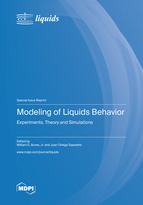Modeling of Liquids Behavior: Experiments, Theory and Simulations
A special issue of Liquids (ISSN 2673-8015). This special issue belongs to the section "Chemical Physics of Liquids".
Deadline for manuscript submissions: closed (30 November 2022) | Viewed by 23771
Special Issue Editors
Interests: chemical and solution thermodynamics; solute transfer properties; phase equilibria
Special Issues, Collections and Topics in MDPI journals
Interests: thermodynamic modeling; EoS; simulation of chemical engineering processes; properties of liquid solutions; behavior of pure liquid and solutions
Special Issues, Collections and Topics in MDPI journals
Special Issue Information
Dear Colleagues,
This Special Issue is focused on theoretical and applied research related to the behavior of both pure liquid and mixtures of organic and inorganic materials. Authors may consider a wide range of pure fluids and solutions with: polar and non-polar substances, polymers, surfactants, ionic liquids and complex and biological molecules. In general, papers describing novel instrumentation, new experimental methods and techniques, original experimental data on thermophysical properties, phase equilibria, modeling and correlation are welcome. Particular attention will be given to research on molecular thermodynamics providing quantitative estimates of liquid systems’ properties, as required for this process. Likewise, papers on models applied to processes such as conventional and supercritical extraction, fractionation, purification, etc., will also be considered.
This Special Issue will act as an international forum for researchers, summarizing the most recent developments and ideas in the field, with a special emphasis on the latest technical and theoretical results. Potential topics include, but are not limited to:
- Measurements, data quality assessment and correlation of liquid properties;
- Modeling of the behavior of pure components and liquid mixtures;
- Theory and applications concerning liquid behavior;
- Equations for states applied for the prediction of interfacial and/or equilibrium properties of pure fluids and heterogeneous mixtures;
- Thermodynamic description of phase equilibrium phenomena;
- Molecular design of co-solvents;
- Separation process simulations and optimization using modeling;
- Others relevant topics.
Prof. Dr. William E. Acree, Jr.
Prof. Dr. Juan Ortega Saavedra
Guest Editors
Manuscript Submission Information
Manuscripts should be submitted online at www.mdpi.com by registering and logging in to this website. Once you are registered, click here to go to the submission form. Manuscripts can be submitted until the deadline. All submissions that pass pre-check are peer-reviewed. Accepted papers will be published continuously in the journal (as soon as accepted) and will be listed together on the special issue website. Research articles, review articles as well as short communications are invited. For planned papers, a title and short abstract (about 100 words) can be sent to the Editorial Office for announcement on this website.
Submitted manuscripts should not have been published previously, nor be under consideration for publication elsewhere (except conference proceedings papers). All manuscripts are thoroughly refereed through a single-blind peer-review process. A guide for authors and other relevant information for submission of manuscripts is available on the Instructions for Authors page. Liquids is an international peer-reviewed open access quarterly journal published by MDPI.
Please visit the Instructions for Authors page before submitting a manuscript. The Article Processing Charge (APC) for publication in this open access journal is 1000 CHF (Swiss Francs). Submitted papers should be well formatted and use good English. Authors may use MDPI's English editing service prior to publication or during author revisions.
Keywords
- liquids
- modeling
- volumetric properties
- molecular interactions
- phase equilibria





